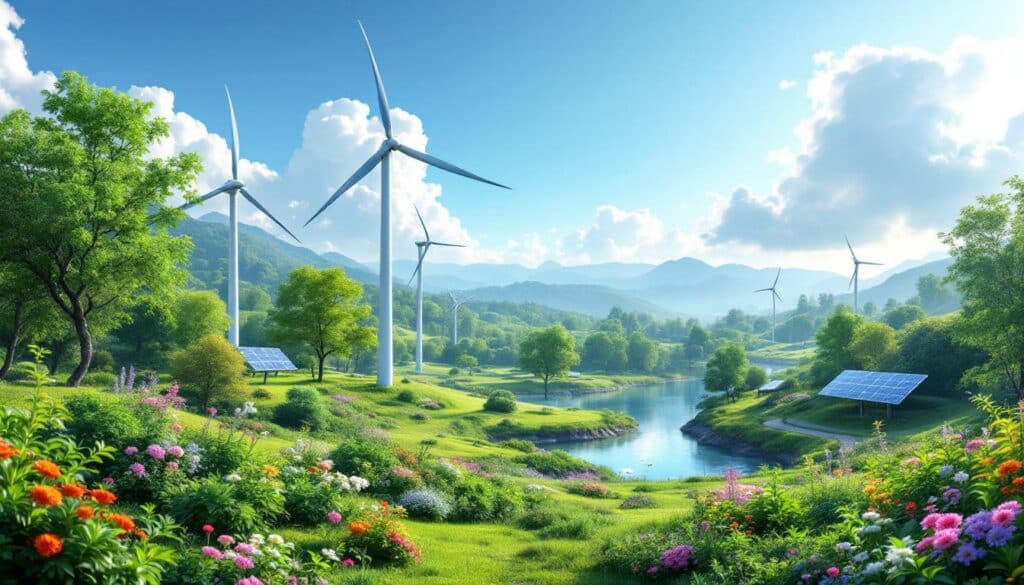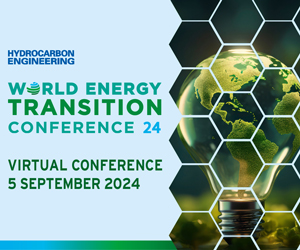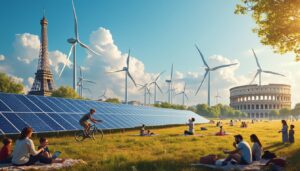Hello, my name is Sophie and I am 29 years old. I am a researcher specializing in bioenergy and waste management. My passion is the valorization of biomass and methanation projects that transform organic waste into renewable energy.
The recent election results in Australia mark a decisive turning point towards renewable energy. The Labor Party, although discreet during the campaign, has unveiled ambitious goals, supported by Anthony Albanese and Minister Chris Bowen. They aim for 82% of the country’s electricity to come from solar, wind, and hydropower by 2030. This vision has been vigorously contested by the Coalition and right-wing organizations tied to fossil fuels, as well as by one of the main Australian media outlets. However, Australians have overwhelmingly rejected these attacks, thus favoring a robust energy transition. Furthermore, the growing support for independents advocates for strengthened actions against climate change and for environmentally respectful management. This shift could position Australia among the global leaders in the fight against the climate crisis by 2025.

Australia: A rapid transition to renewable energy
The Australia is resolutely committed to an energy transition aimed at significantly increasing its capacity in renewable energy. Following the recent elections, the country has demonstrated strong popular support for this ecological shift, thus entrusting the Labor government with the responsibility of successfully implementing this major transformation. This direction is supported by ambitious policies and a clear political will to reduce the national carbon footprint.
The government has set specific goals, notably reaching 82% of electricity from renewable sources such as solar, wind, and hydropower by 2030. These ambitions reflect an increased awareness of climate issues and strong public pressure in favor of sustainable solutions. Additionally, the government relies on federal investment programs like the Capacity Investment Scheme to ensure the massive development of these renewable infrastructures.
This dynamic is also part of a global trend where the capacity for renewable energy is experiencing exponential growth. According to a report by Lirena, the global capacity for renewable energy is expected to increase by 585 GW in 2024, thus strengthening Australia’s position in this strategic sector.
What are the climate goals of the Labor government?
The Labor government of Australia has established an ambitious framework to combat climate change. Among the main initiatives are legislation on energy efficiency standards for vehicles, aimed at encouraging car manufacturers to offer cleaner models. Furthermore, production tax credits have been introduced to stimulate green industries, notably hydrogen, aluminum, and critical minerals.
In addition, the creation of the Net Zero Economy Authority aims to support communities dependent on fossil fuels in their transition to sustainable economic activities. This initiative is essential to ensure a just transition and avoid negative social impacts from energy reforms. Moreover, the overhaul of the safeguard mechanism, a legacy of the previous Coalition, allows for better regulation of greenhouse gas emissions from major industrial sites.
The government also plans to develop sectoral decarbonization plans covering various industries such as electricity, transport, agriculture, and natural resources. These plans will be integrated into a comprehensive net zero strategy, aligned with the recommendations of the Climate Change Authority.
What concrete actions does the Labor government plan?
The Labor government is preparing to implement several concrete actions to accelerate the transition to renewable energy. Among these is a grant program for domestic storage systems, aimed at encouraging the adoption of residential batteries. This initiative aims to stabilize the electricity grid by integrating more intermittent renewable energies such as solar and wind.
Additionally, tax incentives will be offered to companies investing in green technologies, thereby promoting innovation and competitiveness in the renewable energy sector. The government is also committed to strengthening electrical transmission infrastructures to facilitate the integration of new renewable capacities into the national grid.
In parallel, Labor plans to legislate stricter standards for construction and urban planning, in order to promote more energy-efficient buildings. These measures are part of a holistic approach aimed at reducing the carbon footprint of the entire Australian economy.
The Senate Committee is currently reviewing a bill aimed at further regulating the renewable energy sector, thus ensuring a sustainable and controlled growth of the sector (source). This legislative effort is crucial to ensure that future developments meet strict environmental standards and effectively contribute to reducing greenhouse gas emissions.
What challenges does the energy transition face in Australia?
Despite significant advances, the energy transition in Australia faces several challenges. One of the major obstacles is the resistance from certain traditional actors, such as the oil lobby and industrial manufacturers, who oppose new regulations favoring renewable energy (source). This opposition can slow down the implementation of green policies and create political tensions within the government.
Moreover, the fluctuation of investments in renewable infrastructures represents a significant financial challenge. The need to maintain consistent financial support for long-term projects is essential to ensure the continuity and sustainability of energy initiatives. Additionally, managing the transition for workers and communities dependent on fossil fuel industries remains a priority to avoid negative social consequences.
Another major challenge is ensuring a reliable and cost-effective supply of renewable energy. While installed capacities are increasing, it is crucial to ensure that the electrical grids can integrate these new energy sources without compromising system stability. Continuous investments in storage and energy management technologies are necessary to overcome these obstacles.
What role do independents and the green party play in this transition?
The independents and the green party play a crucial role in the current dynamics of the energy transition in Australia. Their massive support for ecological initiatives and their advocacy for climate policies strengthen the Labor government’s position. The independents, notably those supported by community movements, campaign for stronger actions regarding climate change and renewable energies.
The success of the independents is evidenced by a notable increase in their representation and influence within parliament, allowing them to have a greater impact on legislative debates and promote environment-friendly laws (source). Additionally, the green party continues to strengthen its presence in the Senate, where it now holds the balance of power, giving it a strategic position to influence government decisions.
The interactions between the Labor government, independents, and the green party create a political environment conducive to the adoption of bold climate measures. This multiparty collaboration is essential to overcome the encountered obstacles and ensure an efficient and equitable energy transition.
International influence and prospects for Australia
The energy transition in Australia is set against an international backdrop where climate issues are increasingly prioritized. The European Union, for example, plans a record increase in its renewable energy capacity by 2025, even though the sector faces challenges (source). This global dynamic also influences Australian strategies, prompting the country to align its policies with international best practices.
Globally, renewable energy capacity continues to grow, reinforcing opportunities for Australia to become a leader in this field. According to Lirena, this expansion offers Australia the opportunity to export its expertise and technologies, thus contributing to the fight against climate change on a global scale.
Moreover, Australia’s participation in international forums, such as COP31, could strengthen its position on the world stage and attract foreign investments in the renewable energy sector. Hosting such events on Australian territory underscores the country’s commitment to playing an active role in global efforts to reduce carbon emissions and promote sustainable development.
Furthermore, Australia could benefit from strategic partnerships with other nations sharing similar goals, thus facilitating the exchange of knowledge and resources to accelerate the energy transition. These international collaborations are essential to address the complex and interconnected climate challenges the country faces.
What are the next steps for the Labor government?
The Labor government is at a decisive crossroads in its climate policy. Following a resounding electoral victory, many crucial decisions are upcoming to define Australia’s energy future. One immediate priority is to establish a target for emission reductions for 2035, scheduled for next September (source). This target must be ambitious, aiming for a reduction of 65% to 75% from 2005 levels, according to the recommendations of the Climate Change Authority.
At the same time, the government will need to finalize and implement decarbonization plans for the six identified economic sectors. These plans must be quickly developed and aligned with the overarching net zero strategy to ensure a smooth and effective transition. The success of these initiatives will largely depend on the government’s ability to mobilize necessary resources and maintain public support throughout the process.
Additionally, the possible organization of COP31 in Australia could serve as a catalyst to strengthen the country’s international climate commitments. Hosting such an event would not only highlight Australian efforts but also attract global attention to local initiatives and the challenges that remain.
Finally, the government will need to continue engaging with all stakeholders, including traditional industries and emerging players in renewable energies, to promote constructive cooperation and overcome potential resistance. Establishing a national environmental protection agency and rewriting conservation laws represent crucial steps to consolidate achievements and ensure effective environmental governance.
Articles similaires
Thank you!
We will contact you soon.














